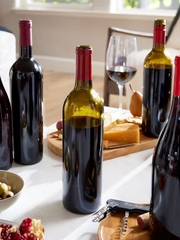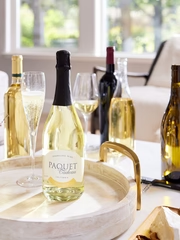 Can the wine have excess sulfur compounds?
When we add sulfur dioxide or SO2 to all our wines, under extreme cases it can form a "struck-match" aroma. Dihydrogen sulfide (H2S) is a naturally occurring bi-product of fermentation gone wrong. The mercaptan notes of rotten egg or burnt rubber are rare but could occur in wine.
Could the wine be oxidized?
Too much oxygen exposure can lead to discoloration, especially for older wines. Bright reds turn to a brownish-orange color and their fresh taste evaporates to become drier and more bitter. Both color and flavor compounds disappear.
Could your wine have suffered heat damage?
Long or intense exposure to heat results in jammy, balsamic characters like a reduction sauce with roasted sugar aromas. Heat damage often compromises the seal of the bottle and oxidation will occur as well.
Could your bottle have been light-struck?
The band AC/DC have "Thunderstruck" their fans for years. The same thing can happen after excessive UV radiation from storing wine in the sun or near a window. White wines are the most susceptible, as they are more often bottled using a clear glass called flint.
Can the wine have excess sulfur compounds?
When we add sulfur dioxide or SO2 to all our wines, under extreme cases it can form a "struck-match" aroma. Dihydrogen sulfide (H2S) is a naturally occurring bi-product of fermentation gone wrong. The mercaptan notes of rotten egg or burnt rubber are rare but could occur in wine.
Could the wine be oxidized?
Too much oxygen exposure can lead to discoloration, especially for older wines. Bright reds turn to a brownish-orange color and their fresh taste evaporates to become drier and more bitter. Both color and flavor compounds disappear.
Could your wine have suffered heat damage?
Long or intense exposure to heat results in jammy, balsamic characters like a reduction sauce with roasted sugar aromas. Heat damage often compromises the seal of the bottle and oxidation will occur as well.
Could your bottle have been light-struck?
The band AC/DC have "Thunderstruck" their fans for years. The same thing can happen after excessive UV radiation from storing wine in the sun or near a window. White wines are the most susceptible, as they are more often bottled using a clear glass called flint.
 Could the cork of your bottle have been tainted?
This is the most common problem you will encounter. The culprit is most likely to be 2,4,6-Trichloroanisole (TCA) AKA "cork taint." Real cork, oak barrels and the processing lines at the winery or facility, are all susceptible to contamination. Musty, wet cardboard or wet newspaper best describes the aroma of the wine in these bottles. I even read somewhere that it's the smell of "Grandma’s basement." I grew up without a basement and I loved my Grandma so I would never get her involved in this. (Love you Nana!)
TCA happens when little airborne fungi come in contact with chlorine and phenolic compounds. World-class ETS wine laboratories in St. Helena have trapped and studied particles everywhere in the U.S. for the past twenty years. Cork taint isn’t bad for you; it's just going to ruin your afternoon. Flavors and aromas are quantified in PPM (parts per million). When your nose detects cork taint, it is at the PPB level (parts per billion). Its strong, pungent smell will keep your nose “tainted” for few minutes after sniffing this molecule.
A professor of wine chemistry at UC Davis claims you can pour wine with cork taint into a bowl with a sheet of plastic wrap. The TCA will be attracted to the polyethylene and be pulled from the wine. Next time things get corky at home, try this method and see if it works.
All of these issues are rare. Proper storage of your bottles in a cool, dark environment will ensure the longevity of your wines. Happy tasting!
Could the cork of your bottle have been tainted?
This is the most common problem you will encounter. The culprit is most likely to be 2,4,6-Trichloroanisole (TCA) AKA "cork taint." Real cork, oak barrels and the processing lines at the winery or facility, are all susceptible to contamination. Musty, wet cardboard or wet newspaper best describes the aroma of the wine in these bottles. I even read somewhere that it's the smell of "Grandma’s basement." I grew up without a basement and I loved my Grandma so I would never get her involved in this. (Love you Nana!)
TCA happens when little airborne fungi come in contact with chlorine and phenolic compounds. World-class ETS wine laboratories in St. Helena have trapped and studied particles everywhere in the U.S. for the past twenty years. Cork taint isn’t bad for you; it's just going to ruin your afternoon. Flavors and aromas are quantified in PPM (parts per million). When your nose detects cork taint, it is at the PPB level (parts per billion). Its strong, pungent smell will keep your nose “tainted” for few minutes after sniffing this molecule.
A professor of wine chemistry at UC Davis claims you can pour wine with cork taint into a bowl with a sheet of plastic wrap. The TCA will be attracted to the polyethylene and be pulled from the wine. Next time things get corky at home, try this method and see if it works.
All of these issues are rare. Proper storage of your bottles in a cool, dark environment will ensure the longevity of your wines. Happy tasting!





